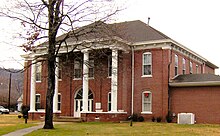Sequatchie County, Tennessee
| Sequatchie County, Tennessee | |
|---|---|

Sequatchie County Courthouse in Dunlap
|
|
|
Location in the U.S. state of Tennessee |
|
 Tennessee's location in the U.S. |
|
| Founded | December 9, 1857 |
| Named for | Cherokee chief |
| Seat | Dunlap |
| Largest city | Dunlap |
| Area | |
| • Total | 266 sq mi (689 km2) |
| • Land | 266 sq mi (689 km2) |
| • Water | 0.2 sq mi (1 km2), 0.07% |
| Population | |
| • (2010) | 14,112 |
| • Density | 53/sq mi (20/km²) |
| Congressional district | 4th |
| Time zone | Central: UTC-6/-5 |
| Website | sequatchiecounty-tn |
Sequatchie County is a county located in the U.S. state of Tennessee. As of the 2010 census, the population was 14,112. Its county seat is Dunlap.
Sequatchie County is part of the Chattanooga, TN–GA Metropolitan Statistical Area.
Sequatchie County was created in 1857 from a portion of Hamilton County. It was named for the Sequatchie Valley, which in turn had been named for a Cherokee chief. The word sequachee in Cherokee means, "opossum" or "he grins or runs." Settlers began arriving in what is now Sequatchie by the early 19th century, drawn to the area by the fertile land in the valley.
At the outset of the Civil War, Sequatchie was divided over the issue of secession. On June 8, 1861, Sequatchie Countians voted in favor of Tennessee's Ordinance of Secession by a vote 153 to 100. In October 1863, Confederate General Joseph Wheeler led a raid into Sequatchie, burning nearly a thousand wagons and capturing livestock.
During the late 19th century, the Douglas Coal and Coke Company (later the Chattanooga Iron and Coal Corporation) conducted extensive mining activities in the Dunlap area. The company constructed 268 beehive ovens, now known as the Dunlap Coke Ovens, to convert coal into coke. The ovens are now the focus of a local park.
According to the U.S. Census Bureau, the county has a total area of 266 square miles (690 km2), of which 266 square miles (690 km2) is land and 0.2 square miles (0.52 km2) (0.07%) is water.
Sequatchie is one of three counties (along with Bledsoe and Marion) situated in the Sequatchie Valley, a long, narrow valley running northeast-to-southwest across the eastern portion of the Cumberland Plateau. The county is flanked by the Plateau's Walden Ridge escarpment on the east. The Sequatchie River, which spans the valley, passes through the county.
...
Wikipedia
